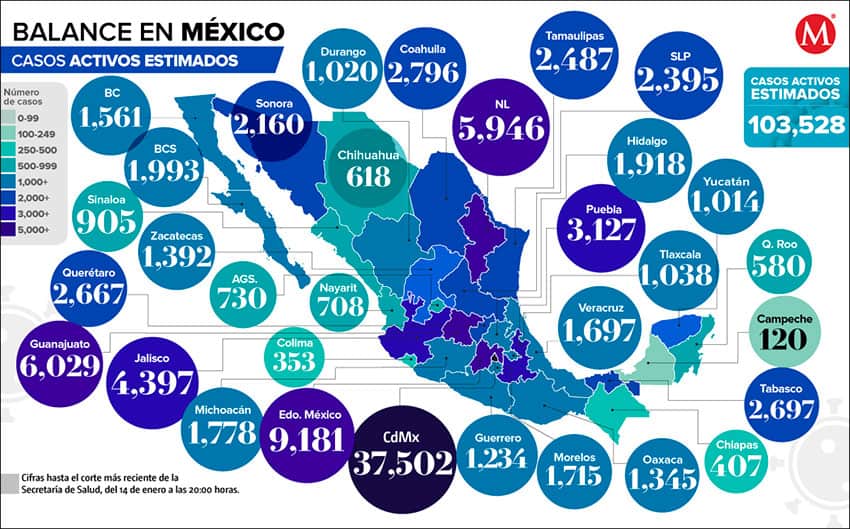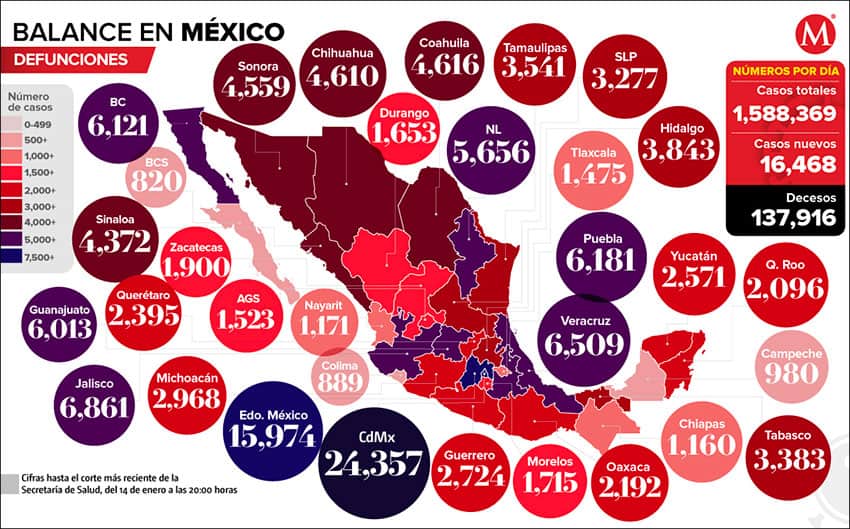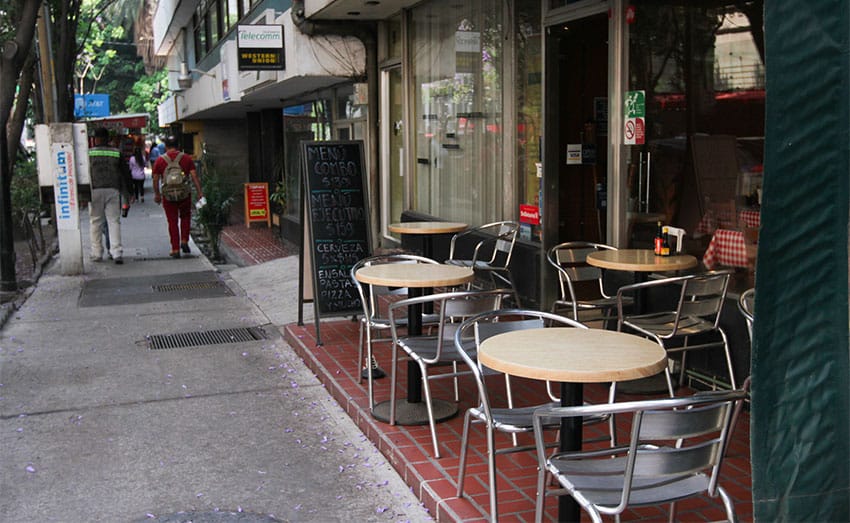The coronavirus pandemic is showing no signs of letting up: the federal Health Ministry reported a new single-day record of 16,468 new cases on Thursday and Mexico City and México state will remain maximum risk red on the stoplight map for another week.
Mexico’s accumulated case tally rose to just under 1.59 million on Thursday while the official Covid-19 death toll increased to 137,916 with 999 additional fatalities registered.
Almost 40% of the new cases and a quarter of the additional deaths came from Mexico City, where 90% of general care hospital beds and 86% of those with ventilators are occupied, according to federal data.
Mayor Claudia Sheinbaum said Friday that the capital will remain at the red light level between January 18 and 24 because hospitalizations are increasing and coronavirus case numbers remain very high.
Government official Eduardo Clark said that 4,464 coronavirus patients were admitted to hospital over the past week, adding that authorities believe the high number of admissions is related to gatherings of family and friends over the Christmas-New Year period.

Acknowledging the difficult situation many people are facing due to the suspension of nonessential economic activities almost a month ago, Sheinbaum announced that some restrictions will be eased on Monday. The objective is to reactivate the economy without risking people’s health, the mayor said.
As of Monday, Mexico City restaurants will be permitted to offer daytime, on-premises dining to customers as long as they are seated outdoors. A maximum of four people will be permitted to sit at the same table and restaurants must end in-house service by 6:00 p.m. after which they will be limited to takeout and delivery service. Diners will be required to scan QR codes with their cell phones to aid contact tracing efforts.
Open air sports classes will also be permitted as of Monday and gyms with outdoor spaces will be allowed to reopen. Supermarkets have been given the green light to operate 24 hours a day, seven days a week. The aim of around-the-clock supermarket shopping is to reduce the number of people in stores at any one time.
In México state, the coronavirus risk level will also remain at red light maximum, Governor Alfredo del Mazo said. As is the case in Mexico City, restaurants will be able to welcome in-house customers in outdoor dining areas as of Monday.
The governor gave no indication about when the state, which includes many municipalities in the greater Mexico City area, might return to a lower risk rating on the stoplight map.
In a video message posted to social media, del Mazo said that there are more coronavirus patients in hospital than at any other time of the pandemic. He said that 84% of hospital beds are occupied and that 505 patients are currently on ventilators.

“I’m convinced that the efforts that have been made have helped but they haven’t been sufficient to reduce the pace of infection and the number of people in hospital,” del Mazo said. “… Our priority is and will continue to be looking after the health of everyone in order to save more lives.”
Mexico City and México state, which rank first and second, respectively, for both accumulated coronavirus cases and Covid-19 deaths are among five states currently red on the federal stoplight map. The other three are Baja California, Guanajuato and Morelos, which also switched to red in late December. On Friday evening the Health Ministry is due to present an updated stoplight map, which will take effect on Monday.
One state that could turn red next week is Nayarit, where state authorities have already tightened restrictions. Due to a recent rise in case numbers in the Pacific coast state – which is currently high risk orange – the Nayarit government on Thursday decreed that restaurants, bars, cantinas and shopping centers must close by 8:00 p.m. between Friday and February 5.
Nayarit residents have been told to remain in their homes after that time unless they work in an essential industry. Churches and other places of worship are limited to online services.
State health official Jorge Berrera said that daily case numbers averaged about 80 in the first two weeks of the year, and there are an estimated 708 active cases. A first shipment of Covid-19 vaccines has arrived in the state but as is the case across Mexico, immunization is currently limited to health workers.
Despite the recent uptick in cases, Nayarit’s accumulated tally is still relatively low. It has recorded 8,573 confirmed cases since the start of the pandemic, the third lowest total among Mexico’s 32 states after Campeche and Colima, and 1,171 Covid-19 deaths.

The national tally of cases is the 13th highest in the world, according to data compiled by Johns Hopkins University, while Mexico ranks fourth for deaths behind the United States, Brazil and India.
Mexico’s case fatality rate – 8.7 per 100 confirmed cases – is the highest among the 20 countries currently most affected by Covid-19. It ranks sixth among the same 20 countries for per capita Covid-19 deaths with 109 per 100,000 inhabitants.
The countries with a higher mortality rate than Mexico are Italy, the Czech Republic, the United Kingdom, the United States and Spain.
The occupancy rate for general care beds across Mexico is currently 60% while 50% of beds with ventilators are taken. As of Thursday night, just under 330,000 people had received a shot of the Pfizer/BioNTech vaccine.
The pace of Mexico’s vaccination program increased significantly this week after a shipment of almost 440,000 doses arrived on Tuesday. But with a population of almost 130 million, Mexico remains a very long way off achieving the level of immunization that will be required to bring the pandemic to an end.
Source: Milenio (sp), El Financiero (sp)
